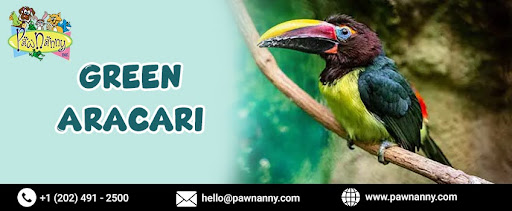
Green Aracari
Scientific Name: Pteroglossus viridis
Flock Members: 2-20 members
Size: 12-16 inches
Weight: 4.2-7.1 ounces
Lifespan: 15-20 years
A.K.A.: Green Aracari Toucans
Behavior
Green Aracari Birds are known for their fascinating behaviors, which reflect their social and arboreal lifestyle. One of the most prominent behaviors of Green Aracaris is their strong social bonds. They typically live in small flocks consisting of family members or bonded pairs. These flocks help in various aspects of their lives, such as foraging, defense, and breeding. Within the flock, they communicate using various calls and vocalizations, maintaining contact and coordinating their activities, requiring Overnight Pet Sitting if their pet parents are away.
Foraging is a crucial behavior for Green Aracaris. They are primarily frugivorous, feeding on a variety of fruits, especially figs, and berries. They use their large, curved bills to pluck fruits from trees, often swallowing them whole or breaking them into smaller pieces with quick movements of their bills. In addition to fruits, they also eat insects, small vertebrates, and occasionally eggs.
Green Aracaris are also known for their nesting behavior. They typically nest in tree hollows or natural cavities, often using old woodpecker holes or abandoned nests. Both male and female aracaris take part in nest building, using materials such as twigs, leaves, and feathers to create a comfortable nest chamber where the female lays her eggs. The male and female share incubation duties, taking turns to keep the eggs warm until they hatch.
History
The Green Aracari, scientifically known as Pteroglossus viridis, is a species of toucan found in the rainforests of South America, particularly in the Amazon Basin. While their exact history isn't extensively documented, these birds have long been inhabitants of the lush tropical forests, playing crucial roles in their ecosystems. Historically, the Green Aracari has been revered by indigenous peoples of South America for its striking appearance and often kept as pets or used in cultural rituals. Their vibrant plumage and unique beak make them unmistakable inhabitants of the rainforest.
In terms of scientific study, Green Aracaris have been of interest to biologists and ornithologists for decades. Their behavior, ecology, and role in seed dispersal have been subjects of research, shedding light on the intricate relationships within rainforest ecosystems. However, the increasing threats to their habitat, primarily due to deforestation and habitat fragmentation, have posed challenges to the survival of Green Aracaris in the wild. Conservation efforts have been underway to protect their habitats and raise awareness about the importance of preserving these beautiful birds and their ecosystems.
Moreover, Green Aracaris have also gained popularity in aviculture, with some individuals being bred in captivity for the pet trade. Their docile nature, striking appearance, and manageable size make them attractive to bird enthusiasts. However, responsible breeding practices and education are crucial to ensure the sustainability of their populations and prevent the negative impacts of illegal trade.
Breeding
Breeding Green Aracari birds is a fascinating process that requires attention to various factors to ensure the health and success of the offspring. These birds typically breed during the rainy season, which varies depending on their geographic location. In their natural habitat of tropical forests in Central and South America, breeding often occurs from March to July. During the breeding season, male and female aracaris engage in courtship behaviors, which include bill tapping, mutual preening, and vocalizations. Once a pair has formed a bond, they begin to prepare a nesting site. Green aracaris nest in tree cavities, often choosing old woodpecker holes or natural hollows in trees. However, they may also use artificial nest boxes provided by conservationists or breeders.
The female aracari lays a clutch of 2 to 4 eggs, which she incubates for about 16 to 18 days. Both parents take turns incubating the eggs and caring for the chicks. Once the eggs hatch, the parents feed the chicks regurgitated fruit and insects. The chicks grow rapidly and fledge the nest after about 6 to 7 weeks. Breeders who keep green aracaris in captivity must provide them with suitable nesting sites and a varied diet to support successful breeding. Proper environmental conditions, including temperature and humidity levels, are also essential for breeding success. Additionally, breeding pairs should be carefully selected to ensure genetic diversity and health in the offspring. With proper care and attention, captive breeding programs can contribute significantly to the conservation of this beautiful bird species.
Looks and Health
The Green Aracari is a strikingly beautiful bird, known for its vibrant plumage and distinctive appearance. Its most striking feature is its brilliant green feathers, which cover most of its body. The head and upper neck are adorned with a bold black band, while the lower neck and chest display a vivid yellow coloration. Their long, slender beaks are brightly colored, with a mix of green, yellow, and orange hues, adding to their overall colorful appearance. Additionally, they have a small patch of red on their rumps, which is often only visible when they take flight.
In terms of health, Green Aracaris requires a balanced diet to thrive. In the wild, they primarily feed on fruits, particularly figs, but they also consume insects, small vertebrates, and eggs. In captivity, a diet consisting of fresh fruits like papaya, grapes, and bananas, supplemented with high-quality pelleted diets and occasional protein sources such as mealworms or crickets, helps to ensure their nutritional needs are met. It's essential to provide them with enough space for exercise and mental stimulation, as they are active birds that enjoy hopping, climbing, and exploring their environment.
Food and Nutrition
The Green Aracari Bird, like many members of the toucan family, has a diet primarily consisting of fruits. In their native habitat of the Amazon rainforest and other tropical regions of South America, they feed on a variety of fruits such as figs, berries, and small fruits like guavas and papayas. These fruits provide essential nutrients like vitamins A and C, which are crucial for the bird's health and immune system. Additionally, Green Aracaris supplement their diet with insects, small lizards, and bird eggs when available. These protein-rich foods help them meet their dietary needs, especially during breeding seasons when extra energy is required for egg-laying and chick-rearing. If you are away, make sure to book pet house-sitting services for your Aracari.
In captivity, it's essential to replicate this varied diet to ensure the bird's nutritional needs are met. This includes offering a mix of fresh fruits such as apples, bananas, and grapes, along with commercial pellet diets specifically formulated for toucans. Insects like mealworms and crickets can also be provided as treats or occasional supplements.
Conclusion
Green Aracaris make captivating pets with their colorful plumage and playful personalities. However, they require specialized care due to their tropical nature. In captivity, they need spacious aviaries with ample room for flying and climbing. A diverse diet of fruits, supplemented with insects and protein sources, is crucial for their health. Regular socialization and mental stimulation are necessary to prevent boredom.
In the wild, Green Aracaris inhabit the canopies of South American rainforests, living in small flocks. They play important roles in seed dispersal and insect control. Their vibrant plumage aids in camouflage and mate attraction. They face threats from habitat loss and illegal pet trade, highlighting the need for conservation efforts. For more information or to avail of our pet house-sitting services in Fairfax, visit PawNanny.com.










